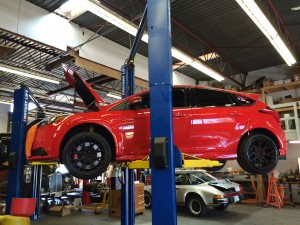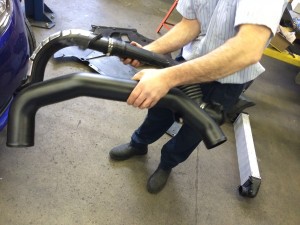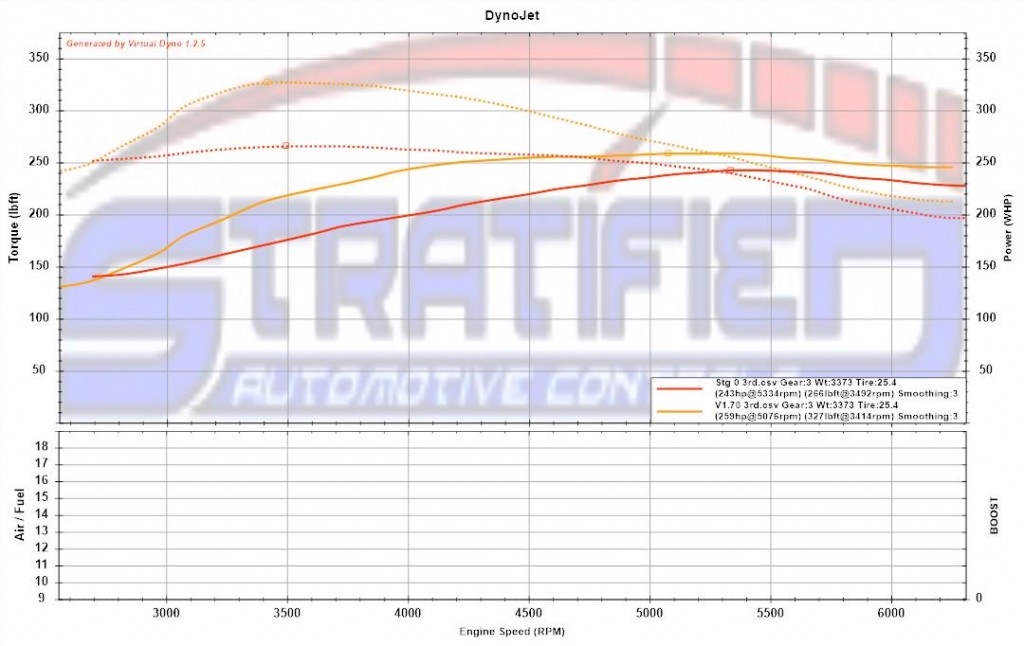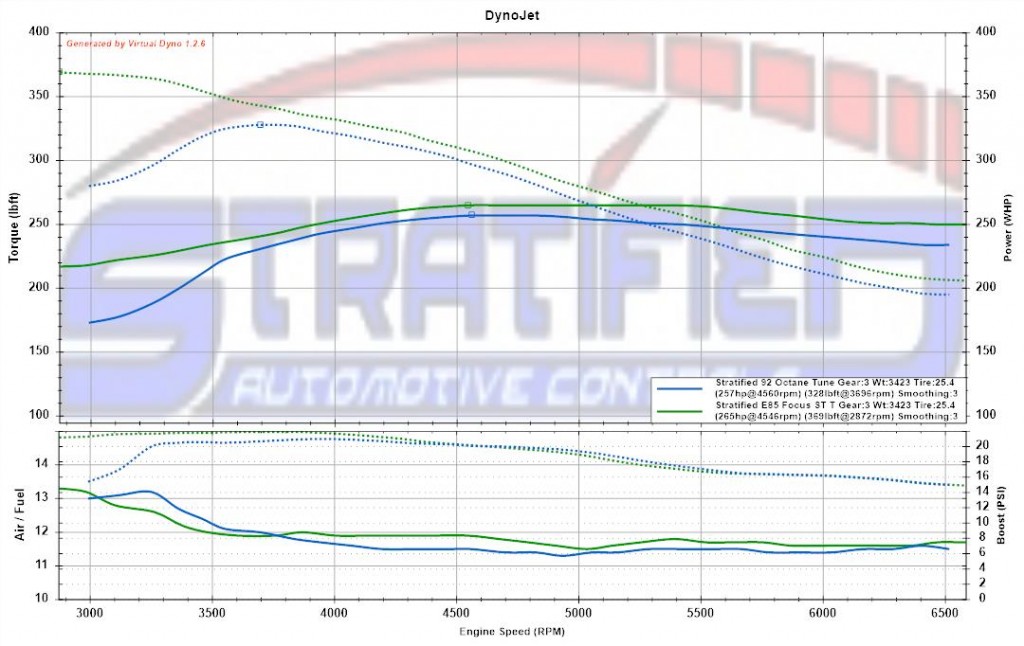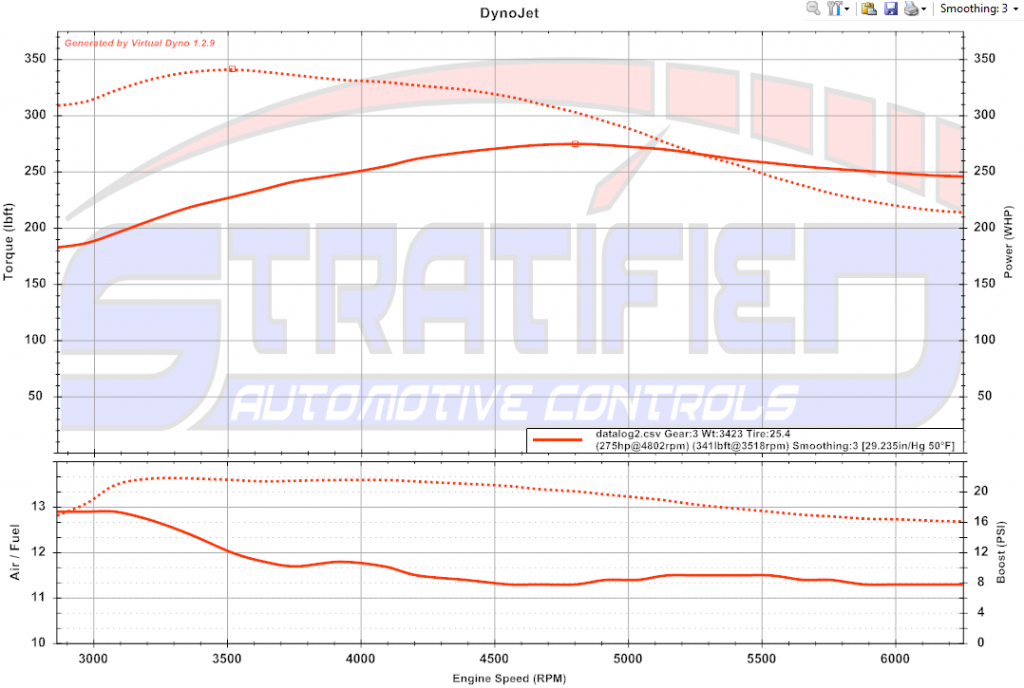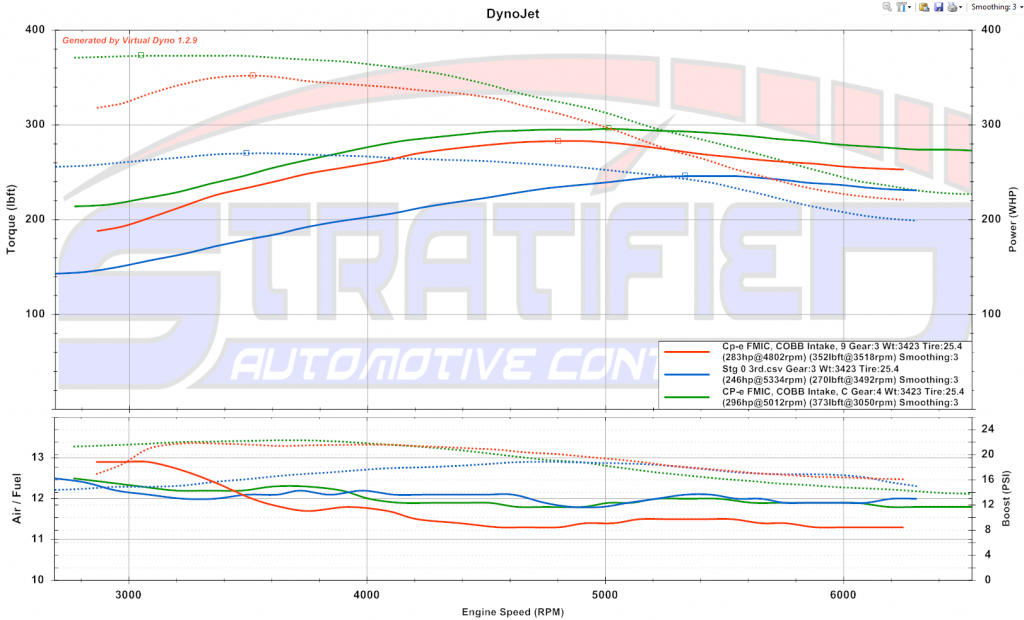This post is intended to be your go-to reference when modifying your EcoBoost powered Ford Focus ST with an informative no BS approach. The 2.0L EcoBoost is a robust and reliable motor and we are happy to fully exploit its benefits. While the stock Focus ST is fun, a little bit of tweaking and tuning quickly turn this little hatch into a force to be reckoned with. Please note that this post covers the modifications which we believe have a significant impact on performance.
For more tech info check out our other articles in the Tech Blog.
One of the most important considerations when buying parts is that you get what you pay for. Buying low quality and often inexpensive parts will end up costing you more in the end or give you unsatisfactory results with poor fitment and/or performance. We see a lot of products in the aftermarket and if we recommend certain parts or carry them, we have tested them and they have the quality and performance you can expect from an upgrade. It is better to save a little longer and purchase quality parts.
There are two basic requirements for increasing power and they work in tandem. The first requirement is to increase airflow through the motor. This is done by increasing boost, installing better flowing parts, all the way up to upgrading to a bigger turbocharger, porting, etc. The other part of the equation is making sure you have enough octane and fuel flow to support the airflow and cylinder pressures without knocking. If you have low octane fuel, even a well flowing motor will not make great power. We will discuss flow increasing parts first and then talk about the importance of fuel and octane.
First, here is the short version to increasing engine performance:
- COBB AP, Stratified Flash Tune, colder plugs, and high flow filter
- Upgraded Intercooler
- Turbo-Back Exhaust
- Stratified Full Custom Tune
- Suspension and Brakes
- 300+ WHP time for a Big Turbo
Getting Started – COBB AP and Stratified Flash Tune 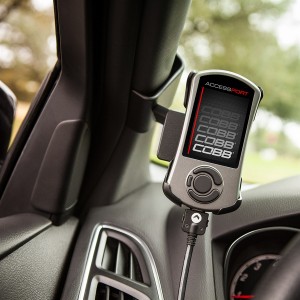
Without a tune, it doesn’t matter what parts you throw on the car, you won’t make significantly more power. Period. These are the days of modern vehicles – they are controlled by computers and those computers must be given the correct information and there is no fooling them. The COBB AccessPort is the perfect solution as it allows you to load any number of tunes onto the vehicle as well as offering excellent dataloging and multiple gauges (for monitoring while your drive). Further, you get extra features such as Map Switching, Launch Control, Flat Foot Shifting, etc. For a big turbo setup (thinking down the road) it is a requirement or boost can’t be controlled reliably without it. When you purchase your COBB AP through us we include one of our Flash Tunes for free. These Flash Tunes are the best place to start as they are created from the OEM calibration and see all the same development and refinement as our full custom tunes. The COBB AP will never become obsolete while you upgrade the car and it will always allow you to update the tune.
Along with the COBB AP you’ll see improvements from switching the stock air filter for a high flow unit (COBB) or installing a full intake. Intake snorkels pointing forward have a ram air effect at high speed and help increase the pressure in the air box which has some benefits as described in this article.
At this point you should also consider moving to one step colder spark plugs. As cylinder temperatures start to rise with increased torque and horsepower you need to run a colder plug to prevent pre-ignition. We recommend either the NGK LTR7IX-11 or Denso ITV-22 gapped down to 0.026″.
Here are some results from our Focus ST back when it was bone stock, with just an AccessPort and tune. At this point you can expect 10-20 WHP and 55-65 lb-ft improvements over OEM depending on your fuel. With E85 add 20-30 WHP and 100 lb-ft to OEM figures. Increasing octane (as done with E85) makes for very significant improvements so don’t hesitate to get an E85 blend tune even on an otherwise stock vehicle
What’s next? Upgrade your intercooler! If you’re like us then you’ve probably been using your new COBB AP to monitor how your vehicle is performing. One thing that will stick out like a sore thumb is just how inadequate the OEM intercooler is. The stock unit is OK for a stock car, however, on a track or driving your favourite back road you’ll notice the Charge Air Temps (CATs) climb very quickly. Not only is the OEM intercooler bad at cooling, it is also a big restriction which your turbo has to fight thus holding you back from making more power. 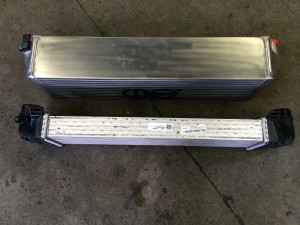
We recommend going for an intercooler with a quality core. The COBB FMIC kit is excellent and includes charge piping, the CP-e intercooler is a monster in size (and cooling) and I would trust anything with a Garrett Core such as the ATP FMIC kit. When it comes to the core it is very important to get something with densely packed fins, you get what you pay for!
Here were our gains from adding on a CP-e 5.5″ FMIC and COBB intake along with updating the tune. At this point the Focus was at 275WHP and 341 Lb-ft on 92 Octane pump gas (it actually made 283WHP without cold-weather corrections). That is an improvement of 32WHP and 75 lb-ft over stock and with the FMIC in place the power was consistent from pull to pull!
Now that you’ve got the basics it’s time to upgrade your exhaust. The biggest restriction on the OEM exhaust is actually the small OEM turbo. If you keep the stock turbo, a downpipe and cat-back have less of an impact on performance, but they really start to shine when a bigger turbo is used. An aftermarket downpipe is going to help you spool faster as well as make more power. We recommend a 3″ downpipe with or without a catalytic converter (cat). The choice to go catless is up to you; on the OEM turbo the cat will not be a significant restriction, however, with bigger turbos the cat will cost you around 20-25hp when making 400whp. The more power you make, the more it will act as a restriction.
After the downpipe it is time to upgrade you cat-back exhaust. The cat-back is what will most significantly change the sounds your car makes, We run a full COBB turbo-back and love the sound it makes.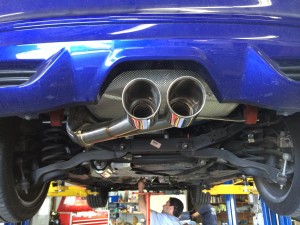
From our testing we’ve found a full turbo back exhaust to give gains of roughly 10-15WHP on top of speeding up spool and sounding better on the OEM turbo. Once you open up the exhaust, the ST snaps and burbles with the best of them!
Your car is “Fully Bolted” with the OEM turbo; the only thing left is a Custom Tune … or step into a Big Turbo and add More Fuel. Now that you’ve got the intercooler, intake, and exhaust you’ve reached the point where a custom tune will make the biggest difference as far as power, driveability and reliability are concerned. A Stratified Flash Tune will still serve you well, however, those of you after the last 5-10% on the stock turbo will enjoy a full custom tune. With a custom tune and the modifications mentioned above you should be just under 300whp on a healthy motor running excellent fuel (E85 blend or WMI). At this point the stock K03 turbo becomes the biggest restriction.
Below are the results from our Focus once it was “Fully Bolted”. In this datalog we are running an E85 blend with a CP-e FMIC, COBB Turbo-Back, COBB intake, and a CP-e exhale charge pipe with a Tial Q valve. With these mods we made 296 WHP and 373 Lb-ft. This is 53WHP and 103 lb-ft more than the OEM baseline! This is the limit of the OEM turbo, and those looking to make over 300WHP will need to step up to a bigger turbo.
Hungry for more? Luckily for you there are a vast number of turbo options for the Focus ST and these are covered in detail in our Ford Focus ST Big Turbo Upgrade Guide. At this point you’ll also run out of available fuelling due to the HPFP (high pressure fuel pump) running out of steam. You’ll be needing a Stratified Aux Fuel Kit to meet your big power fuelling needs.
Increasing Octane through E85 and WMI (water methanol injection). The Ford EcoBoost engine (as well as most others) see significant increases in performance from increasing timing up to the point of mean best torque (MBT) and being able to run higher cylinder pressure (and boost) without knock. Using 91 and even 93 fuel (with some exceptions) caps power as we reach the knock threshold of the fuel. In order to increase the knock threshold the octane of the fuel must be increased. Different geographical areas have access to different fuel qualities (and 93 octane is not the same everywhere believe it or not) so it is very important to choose the best octane available locally and use a well frequented gas station (we recommend top-tier stations such as Shell and Chevron).
Further to this, octane can be increased significantly by blending some E85 (2-4 gallons per tank) or, if E85 is not available, installing a water methanol injection (WMI) kit. These fuel changes can yield significantly more power (20-30whp on a stock turbo, even more on a big turbo) and they do require a Stratified E85 Flash Tune or a custom tune. Read our technical write-up on the benefits of E85 for a more in depth analysis of running ethanol blended fuels. You can also read about the results of installing WMI on our Focus ST. The bottom line is that E85 blends or WMI can be used on the Focus ST with great benefits at any stage of modification as long as you have a tune that is set up for E85 or WMI.
Other, “Optional”, modifications:
BOV/BPV Upgrades. This is under the “optional” modifications as there are no real performance benefits from upgrading to an aftermarket BOV on the Focus ST with an OEM turbo. The OEM K03 turbo comes with an integrated BPV which is fast and has no problems holding boost. That being said, this does become a mandatory modification if you are switching to a Garrett 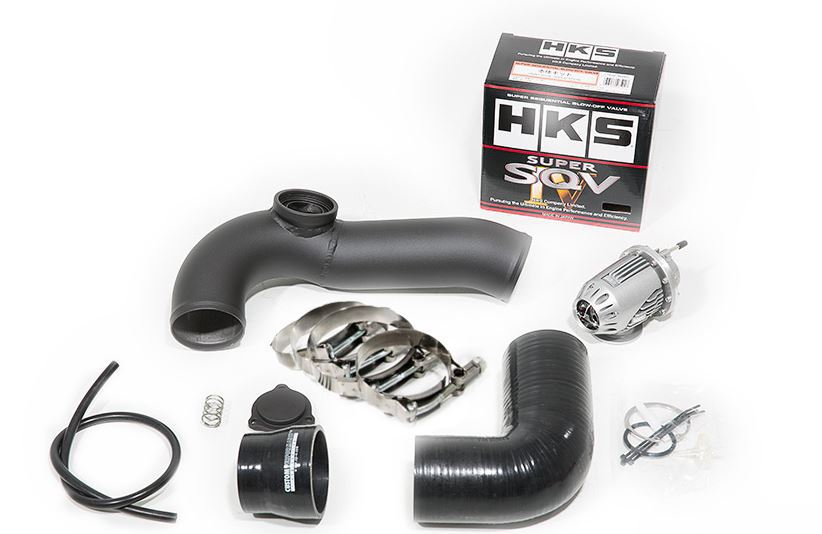 turbo as those turbos do not come with an integrated BPV (unlike OEM or EFR). Although these do not add any power many people feel the Focus ST is too quiet or simply love the sound a BOV makes. The best way to install a BPV on your Focus ST is a CP-e Exhale Kit with either a Tial Q valve or, for those of you who prefer a louder blow-off, the classic HKS SSQV. Another benefit of the CP-e Exhale kit is that it gives you a very convenient bung in case you ever decide to install WMI.
turbo as those turbos do not come with an integrated BPV (unlike OEM or EFR). Although these do not add any power many people feel the Focus ST is too quiet or simply love the sound a BOV makes. The best way to install a BPV on your Focus ST is a CP-e Exhale Kit with either a Tial Q valve or, for those of you who prefer a louder blow-off, the classic HKS SSQV. Another benefit of the CP-e Exhale kit is that it gives you a very convenient bung in case you ever decide to install WMI.
Upgrading your motor mounts for keeping things under control. Upgrading your rear motor mount is a good thing to do if you plan on drag racing as the OEM unit is not stiff enough to handle hard launches at higher power levels. This adds a little extra vibration but if you drive your car hard this is a must since the stock one allows for too much engine movement. Replacing the side motor mounts is not something we recommend for street driven cars as the OEM units work well and aftermarket side motor mounts add a lot of vibration. If you daily drive your car chances are you will dislike upgraded side motor mounts.
Intake Manifold or Throttle Body Spacers offer a convenient place to add WMI nozzles (make sure the WMI kit comes with a solenoid) but otherwise do not make significant performance improvements.
Upgraded fuel injectors – These are taken from another OEM application and are compatible with the Focus ST. However, our fueling limitations are not related to the injector (at least not yet). The high pressure fuel pump is actually the first thing that runs out of flow on the Focus ST and currently there are no cost effective available upgrades for the cam driven HPFP. Save your money and buy a Stratified Aux Fuel Kit for your big power needs which covers the injector as well as the HPFP pump upgrade.
Coilover Suspension. We like to build well balanced cars that maintain the OEM+ standard. In this regard, we feel it is necessary to upgrade all aspects of a car throughout its life. This is why we consider upgraded coilover suspension a must. There are a number of options and our Focus has the Bilstein PSS 14 coilovers which we love! These coilovers reduce body roll, increase cornering stiffness, and quicken the steering response all while providing a ride which feels more refined than OEM. On top of these we also have the COBB Anti-Sway Bars. 
Stopping Power – Upgraded brakes. In line with the above comments on a well balanced car you should consider upgrading your brakes as power levels start to rise. For 2015 the Focus ST received slightly larger rotors which help with braking performance, however, the pad compound still leaves something to be desired. We recommend high performance pads such as the HAWK HPS, HP+, or true race only pads for competition. The added stopping power and heat capacity make upgraded pads a necessity for even light HPDE events. Don’t forget to upgrade the brake fluid if you are going to take the car to a road course!
Engine Cooling – Plain and simple the EcoBoost motors are reliable, Our Big Turbo Focus ST has been daily driven at 400 whp with Aux Fueling for over 10,000 miles without any issues. This includes drag racing, autocross, canyon runs, and over 1,000 highway datalogs and countless more unlogged pulls. That being said, high temperatures are a killer. Anyone who has tracked their modified Focus ST on a road course will tell you that the car overheats and it does so rather quickly. Our Focus still has the OEM cooling system (bolstered by the use of WMI) which we drive hard daily while trying to find the limits of the platform and we have never seen the temperatures rise on the street. The moral of the story is that you must know the application of your vehicle and set it up accordingly. We recommend any car that will see track time install an external oil cooler with a quality core and/or an upgraded radiator. Other cooling tricks include fully removing all grille shutter systems to allow the most airflow through the radiator and intercooler. Daily driven / cars driven hard on the street (canyon runs, highway pulls) or autocrossing and drag racing will be safe without an oil cooler even with upgraded turbos past 400whp. We’ve also found that a WMI kit works wonders to keep Exhaust Gas Temperaturs (EGTs) down. Upgraded intercoolers, and wrapping/shielding your intake tube also help with temperatures.
Thanks for reading, hope you enjoy the road to modifying your ST whichever path you choose to take and if you have any inquiries or parts/tuning questions please don’t hesitate to Contact Us.
– The Stratified Team


